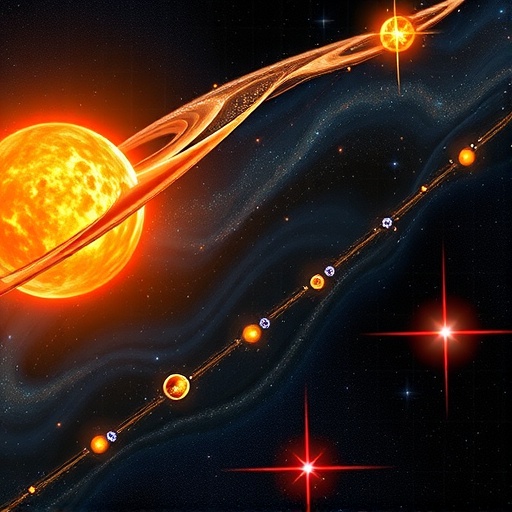A new breakthrough in astrophysics has emerged, providing profound insights into the formation of the universe’s earliest massive stars. Researchers from the School of Physics and Astronomy at Tel Aviv University, alongside colleagues from other prominent institutions, have presented compelling evidence that most of these colossal stars were born in binary systems—pairs of stars that orbit each other closely. This discovery not only reshapes our understanding of stellar evolution but also contributes to our overall comprehension of cosmic phenomena, ranging from supernova explosions to the formation of black holes.
The research indicates that massive stars, which are defined as those exceeding ten times the mass of our Sun, play a pivotal role in the evolution of galaxies and the generation of heavy elements within the cosmos. The energy output from a single massive star can surpass that emitted by over a million Sun-like stars combined, establishing their significance in the grand scheme of cosmic evolution. By influencing the structure and transformation of their host galaxies, these stars are responsible for the creation of neutron stars and black holes, celestial objects that have captivated astronomers for decades.
According to the research team, including lead investigator Dr. Tomer Shenar, the phenomenon of massive stars forming within binary systems is well-documented in our own Milky Way galaxy. Binary systems are crucial to the life cycle of massive stars, allowing them to exchange materials and, in some instances, merge. These interactions have a fundamental impact on their evolutionary paths and eventual fates, raising intriguing questions about whether such patterns existed in the younger universe.
Current observational challenges hinder the direct study of distant massive stars. The James Webb Space Telescope, however, is playing a vital role in advancing our understanding of early galactic structures created shortly after the Big Bang. Despite its capabilities, the vast distances involved make it impossible to thoroughly analyze the specific structures of these stellar systems.
To overcome these limitations, Dr. Shenar and his team devised a detailed observational survey known as the Binarity at LOw Metallicity (BLOeM) project. By focusing on a galaxy relatively nearby, the Small Magellanic Cloud, which mirrors the low metallicity conditions of the early universe, the researchers could draw valuable comparisons. Their two-year observational campaign utilized the VLT in Chile, where they captured spectra from approximately 1,000 massive stars, aiming to unveil the binary nature of these star systems.
Through meticulous spectral analysis, they were able to detect periodic motions indicative of companion stars. Analyzing a subset of 150 of the most massive stars revealed a remarkable finding: at least 70% exhibited characteristics consistent with being part of close binary systems. This finding stands as the first concrete evidence that massive stars have historically existed in binary pairings even under the extreme conditions prevalent in the universe’s formative years, potentially occurring more frequently than in the present era.
The implications of this research reach far beyond the dynamics of massive star formation. It sheds light on the processes responsible for generating a spectrum of cosmic phenomena, including how black holes of varying scales come into being. The shared fate of stars within binarity fundamentally alters the nature of supernova explosions, thereby influencing the distribution of heavy elements—essential ingredients for subsequent generations of stars, planets, and potentially life itself.
As the study unfolds, researchers anticipate that this newfound understanding will trigger fascinating discussions regarding the evolution of the universe and its aspects that remain veiled in mystery. The production of heavy elements during and after supernova events plays a critical role in the chemical enrichment of galaxies, serving as the building blocks for not only celestial bodies but also the very existence of life as we know it.
The innovative approach by Dr. Shenar and his team signifies a pivotal advancement in our understanding of binary star systems and their prevalence in the early universe. This research is a thrilling chapter in the ongoing story of stellar evolution, one that will undoubtedly inspire further inquiry into the mysteries of the cosmos. As we continue to explore the implications of these findings, the relationship between massive stars and their binary companions will remain a vital area of investigation.
In summary, this groundbreaking study offers a fresh perspective on the intricate web of cosmic connections that defines our universe, fostering a deeper appreciation for the critical role massive stars play in shaping the fabric of the cosmos. With each new discovery, our understanding of the universe and our place within it grows richer, paving the way for continued exploration of the stellar processes that govern the birth and death of stars.
Subject of Research: Formation of massive stars in binary systems
Article Title: A Scientific Breakthrough in Understanding the Formation of the Universe’s First Stars
News Publication Date: Not provided
Web References: Not provided
References: Not provided
Image Credits: Credit: Tel Aviv University
Keywords
Cosmic phenomena, massive stars, binary systems, supernovae, black holes, astrophysics, stellar evolution, chemical enrichment, universe, Tel Aviv University.




